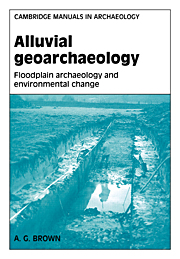Book contents
- Frontmatter
- Contents
- List of illustrations
- List of tables
- Preface
- Acknowledgements
- Introduction and the example of the Nile
- PART I PRINCIPLES
- PART II APPLICATION
- 5 Artifacts from floodplains and rivers
- 6 The rise and fall of forested floodplains in North-West Europe
- 7 Buried sites
- 8 Managed floodplains
- 9 The cultural archaeology of floodplains
- 10 People, floodplains and environmental change
- APPENDICES
- References
- Subject Index
- Index of rivers and sites
5 - Artifacts from floodplains and rivers
Published online by Cambridge University Press: 03 December 2009
- Frontmatter
- Contents
- List of illustrations
- List of tables
- Preface
- Acknowledgements
- Introduction and the example of the Nile
- PART I PRINCIPLES
- PART II APPLICATION
- 5 Artifacts from floodplains and rivers
- 6 The rise and fall of forested floodplains in North-West Europe
- 7 Buried sites
- 8 Managed floodplains
- 9 The cultural archaeology of floodplains
- 10 People, floodplains and environmental change
- APPENDICES
- References
- Subject Index
- Index of rivers and sites
Summary
This chapter is concerned with the palaeoenvironmental and archaeological record that has been derived from terrace gravels and associated sediments. In these contexts archaeological sites are generally either accumulations of derived artifacts or concentrations of discarded tools associated with temporary camps. The cultures responsible are predominantly non-agricultural and although they undoubtedly had impacts on the environment, floodplains were essentially natural. The combination of geology, geomorphology and archaeology needed to study these sites is typical of the sub-discipline of geoarchaeology and alluvial geoarchaeological studies from both North America and Australia are described here as the clearest examples of this type of archaeology. The multi-disciplinary approach is exemplified by the Thames, England; however, the palaeoenvironmental data have been accumulated over many years, leading, unsurprisingly, to variations in coverage and quality which make unrealistic a definitive Pleistocene and archaeological history of this and other rivers. Instead, the discovery and excavation of new sites will lead to the revision (or abandonment) of current models (Gibbard, 1994; Bridgland, 1994) just as they revised models before them (King and Oakley, 1936).
Palaeolithic terrace sites and floodplain use
Artifacts and bones from river gravels form some of the earliest evidence of the peopling of North America and Australasia. The archaeology of the Palaeolithic in Europe is also predominantly derived from terrace gravels, caves and rock fissures.
- Type
- Chapter
- Information
- Alluvial GeoarchaeologyFloodplain Archaeology and Environmental Change, pp. 149 - 191Publisher: Cambridge University PressPrint publication year: 1997



